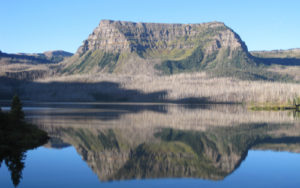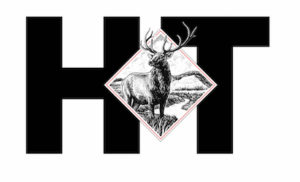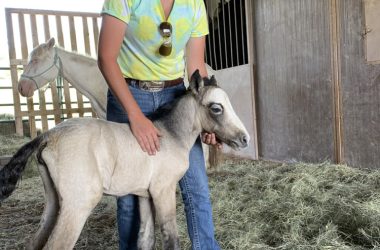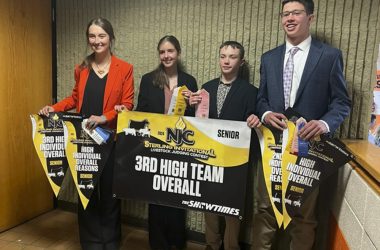
Wilderness remained a flexible concept, having evolved far beyond Arthur Carhart’s original plans for Trappers Lake and the Forest Service’s designs for the region. This flexibility was a product of the fact that the Wilderness Act required the creation of wilderness areas to be a public matter decided by Congress rather than by a federal agency.
In other words, although the Forest Service referred to Trappers Lake as “a symbol of the serenity that is wilderness,” the debate over its fate remained anything but serene as a variety of groups applied their own understandings of wilderness to the place in the decades following the Wilderness Act.
The Forest Service formally recommended the Flat Tops as an addition to the National Wilderness Preservation System in 1967. Encompassing 142,230 acres, the proposed Flat Tops Wilderness Area featured a couple of new additions to complement the original primitive area that the agency had created in 1932.
Trappers Lake was chief among them, now eligible for wilderness designation since the Bureau of Reclamation relinquished its claim on the lake in 1964. Moreover, the proposed wilderness area spanned across the summit of the Flat Tops — the series of highlands that comprise the White River Plateau — and included vast expanses of Engelmann spruce forest recently devastated by a spruce bark beetle epidemic.
Wilderness designation, the Forest Service argued, would provide a “natural laboratory” to monitor the forest’s recovery. However, the proposed Flat Tops Wilderness Area was to remain a land of many uses where outdoor recreation and forest research complemented other natural resource values.
One could argue that recreation was a minor use of the Flat Tops, as the Forest Service had recorded only 4,300 visits to the area in 1964. In contrast, 820 cattle and 20,000 sheep grazed in the Flat Tops during the summer months.
There was also significant demand for the water that the region provided, namely from the White River. For this reason, the Forest Service labeled watershed protection as the most important use of the potential wilderness area, stating the importance of providing a steady flow of water to users downstream.
The agency also omitted the South Fork of the White River from wilderness designation because interests who hoped to develop the mineral potential of the Piceance Creek Basin and other oil shale regions downstream had already claimed the headwaters of the South Fork as a viable place to develop hydropower and water storage facilities.
Disagreements quickly emerged between the Forest Service and environmental organizations that challenged the agency’s multiple-use approach to wilderness preservation. Perhaps the most well-known of these conflicts came during the 1980s and 1990s, when the Forest Service confronted Earth First! and other radical groups over the fate of timberlands and the spotted owl in the Pacific Northwest.
Although nothing to this magnitude ever occurred in the Flat Tops, the Forest Service still faced challenges to its proposal from groups with their own visions of wilderness preservation and natural resource management in the region.
Reaction to a possible Flat Tops Wilderness Area was overwhelmingly positive, but divisions quickly emerged over exactly how much of the Flat Tops was to become wilderness.
Members of the public ultimately brought four different proposals for the Flat Tops in addition to the Forest Service’s original proposition during the review process. The most significant of these was a suggestion introduced by the Colorado Open Space Coordinating Council (COSCC) and supported by national organizations such as the Wilderness Society that called for a Flat Tops Wilderness Area comprising more than 230,000 acres.
The COSCC argued that its proposal incorporated a greater variety of landscapes (rather than the summit of the White River Plateau alone) and facilitated easier access to the recreational opportunities that the Flat Tops had to offer. But the Forest Service opposed the COSCC’s proposed additions to the Flat Tops Wilderness Area on the grounds that they were unsuitable for wilderness designation, lacked well-defined natural boundaries and conflicted with other natural resource values.
As it argued, the resources provided by the Flat Tops — water, wilderness or otherwise — could only be met “through the planned development and wider use” of the region rather than “through (its) management as wilderness.” This statement espoused the agency’s faith in expertise, scientific management and multiple-use, but it also constrained the potential of the Flat Tops as wilderness.
That Congress ultimately disagreed with the Forest Service was a testament to the political process created by the Wilderness Act.
A House subcommittee dismissed claims regarding the hydropower and water storage potential of the South Fork of the White River, making it eligible for wilderness designation. Furthermore, although Congress accepted the importance of watershed protection within the Flat Tops, it decided that the COSCC’s proposal was the best way for the Forest Service to meet those obligations. Thus, when President Gerald Ford signed “An act to designate the Flat Tops Wilderness” on Dec. 12, 1975, the result was an area that encompassed 235,239 acres, far larger than the Forest Service’s original proposal.
Trappers Lake and the Flat Tops Wilderness Area has always been influenced by politics, culture and ideas regarding the proper relationship between humans and nature in modern society.
Arthur H. Carhart helped start this conversation following his visit to Trappers Lake in 1919. More important, Carhart continued to investigate this issue for the rest of his life, and we need individuals like him to continue this mission today.
Carhart acknowledged that wilderness featured certain physical characteristics, chiefly the absence of developments such as roads and automobiles. Thus, in his book Planning for America’s Wildlands, Carhart accepted the possibility that wilderness could begin “wherever we face away from man-dominated landscapes.” Yet, wilderness is also a product of emotions associated with the freedom from modern-day conveniences and constraints.
The challenge that agencies like the Forest Service face in managing these places is that an individual’s experience in the wild depends as much on their own background and expectations as it does on the scenery.
“Wilderness is not entirely made up of unscaled pinnacles, faint, little-trodden trails, great solitude, vast space surrounding; those are physical things of wilderness,” Carhart wrote. “Your wilderness,” he continued, “is what you glean in sensory treasures from living with them and living as a part of the geo-ecological habitat.”
In other words, wilderness is a distinct place on the American landscape. But it is also a state of mind; one that means different things to different people.
The significance of the Wilderness Act lies in the political process it created, which allows our understandings of wilderness to continue to evolve. As a result, the National Wilderness Preservation System under its care is incredibly diverse with areas as large as 9 million acres and place names ranging from Alaska’s Denali National Park and Preserve to New Jersey’s Great Swamp National Wildlife Refuge.
The National Wilderness Preservation System is restricted to lands owned by the federal government, but wilderness areas also exist at state and municipal levels. For instance, the wilderness area I am most familiar with today exists within an urban setting: The Sutton Urban Wilderness Area in Norman, Okla. Though different from Trappers Lake, its benefits are similar—public access, solitude, relative absence of human development—and it provides another means through which humans can experience “the serenity that is wilderness.”
The wilderness idea continues to evolve and exist under a variety of contexts. It also provides opportunities for humans to seek respite from the modern world and acknowledge that they are part of a much larger community.
Through the work of individuals like Arthur Carhart and laws such as the Wilderness Act, wilderness can be one means through which humans can develop an ethical, sustainable relationship with nature.
In commemoration of the golden anniversary of the wilderness act, go to the wilderness. Any wilderness.
The author consulted the following published works, all of which provide information on Trappers Lake, wilderness and modern environmental politics. If you have any questions, comments, or concerns about Trappers Lake and the wilderness idea, you may contact the author via email at [email protected]:
Baldwin, Donald N. The Quiet Revolution: Grass Roots of Today’s Wilderness Preservation Movement. Boulder: Pruett Publishing Company, 1972.
Carhart, Arthur H. Planning for America’s Wildlands. Harrisburg: National Audubon Society, National Parks Association, The Wilderness Society, and Wildlife Management Institute, 1961.
Harvey, Mark W. T. Wilderness Forever: Howard Zahniser and the Path to the Wilderness Act. Seattle: University of Washington Press, 2005.
Nash, Roderick Frazier. Wilderness and the American Mind, 4th ed. New Haven: Yale University Press, 2001.
Philpott, William. Vacationland: Tourism and Environment in the Colorado High Country. Seattle: University of Washington Press, 2013.
Steen, Harold K. The U.S. Forest Service: A History, centennial ed. Durham: Forest History Society in association with University of Washington Press, 2004.
Sutter, Paul S. Driven Wild: How the Fight against Automobiles Launched the Modern Wilderness Movement. Seattle: University of Washington Press, 2002.
Turner, James Morton. The Promise of Wilderness: American Environmental Politics since 1964. Seattle: University of Washington Press, 2012.
Wolf, Tom. Arthur Carhart: Wilderness Prophet. Boulder: University Press of Colorado, 2008.
By Matt Pearce
Special to the Herald Times




















